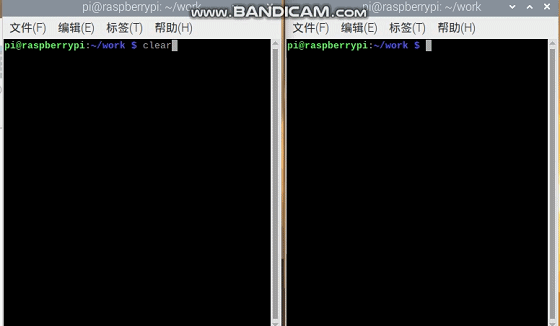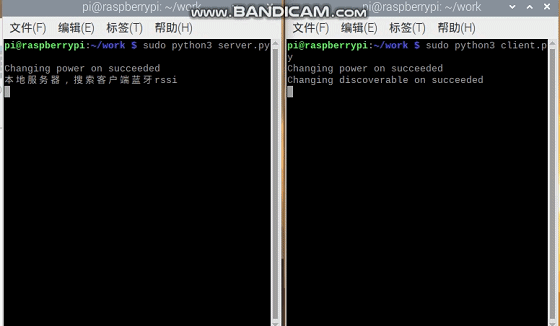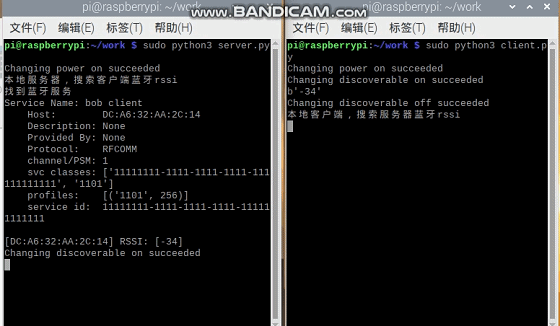若该文为原创文章,转载请注明原文出处
本文章博客地址:https://blog.csdn.net/qq21497936/article/details/110940484
长期持续带来更多项目与技术分享,咨询请加QQ:21497936、微信:yangsir198808
红胖子(红模仿)的博文大全:开发技术集合(包含Qt实用技术、树莓派、三维、OpenCV、OpenGL、ffmpeg、OSG、单片机、软硬结合等等)持续更新中…(点击传送门)
上一篇:《树莓派开发笔记(十):Qt读取ADC模拟量电压(ADS1115读取电压模拟量)》
下一篇:敬请期待…
接下来介绍树莓派蓝牙模块的开发,使用的协议为bluez。
请参照博客《树莓派开发笔记(一):入手树莓派3b,成功运行树莓派系统》

客户端bob,服务器alice,探测两方的rssi,并传送给服务器alice



BlueZ是官方Linux Bluetooth栈,由主机控制接口(Host Control Interface,HCI)层、Bluetooth协议核心、逻辑链路控制和适配协议(Logical Link Control and Adaptation Protocol,L2CAP)、SCO 音频层、其他 Bluetooth 服务、用户空间后台进程以及配置工具组成。
BlueZ由许多单独的模块组成:
- 蓝牙内核子系统核心
- L2CAP和SCO音频内核层
- RFCOMM,BNEP,CMTP和HIDP内核实现
- HCI UART,USB,PCMCIA和虚拟设备驱动程序
- 通用蓝牙和SDP库和守护程序
- 配置和测试实用程序
- 协议解码和分析工具
sudo apt-get install bluez
hciconfig

sudo hciconfig hci0 up

sudo hciconfig iscan

(注意:不好用,显示的都是mac地址,而且中文乱码,周围蓝牙多,根本分不清楚)
bluetoothctl

power on/off


电脑上的蓝牙,先打开:

sudo python3 -m pip install pybluez
# -*-coding: utf-8 -*-
from bluetooth import *
import sys
import time
import os
import struct
import bluetooth._bluetooth as bluez
import bluetooth
global hostRssi
os.system("bluetoothctl power on")
# 获取服务,通过uuid查找目标服务
#uuid = "63078d70-feb9-lle7-9812-dca90488bd22"
#os.system("bluetoothctl discoverable on")
dstuuid = "11111111-1111-1111-1111-111111111111"
localuuid = "22222222-2222-2222-2222-222222222222"
print("本地服务器,搜索客户端蓝牙rssi")
...
data = client.recv(1024)
print (data)
client.close()
bluetooth_sock.close()
from bluetooth import *
import sys
import time
import os
import struct
import bluetooth._bluetooth as bluez
import bluetooth
global hostRssi
#开启蓝牙可见
os.system("bluetoothctl power on")
os.system("bluetoothctl discoverable on")
dstuuid = "22222222-2222-2222-2222-222222222222"
localuuid = "11111111-1111-1111-1111-111111111111"
bluetooth_sock=BluetoothSocket(RFCOMM)
bluetooth_sock.bind(("",PORT_ANY))
bluetooth_sock.listen(1)
...
data = "server:" + str(hostRssi) + ", client:" + str(clientRssi)
...

sudo vim /lib/systemd/system/bluetooth.service
修改文件内容
#ExecStart=/usr/lib/bluez5/bluetooth/bluetoothd
ExecStart=/usr/lib/bluez5/bluetooth/bluetoothd -E -C
&emso;&emso;然后重启服务
sudo sdptool add SP
sudo systemctl daemon-reload
sudo systemctl restart bluetooth
sudo sdptool browse local

原因:由于蓝牙不可见导致
上一篇:《树莓派开发笔记(十):Qt读取ADC模拟量电压(ADS1115读取电压模拟量)》
下一篇:敬请期待…
若该文为原创文章,转载请注明原文出处
本文章博客地址:https://blog.csdn.net/qq21497936/article/details/110940484